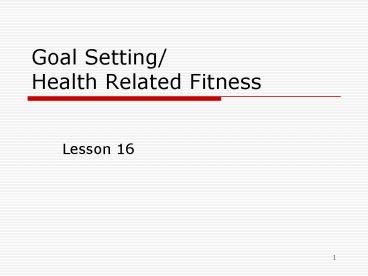Goal Setting/ Health Related Fitness - PowerPoint PPT Presentation
1 / 21
Title:
Goal Setting/ Health Related Fitness
Description:
* Goal Setting Setting goals is essential to the success of any effort. Short-term goals Goals that can be accomplished relatively easily and quickly. – PowerPoint PPT presentation
Number of Views:701
Avg rating:3.0/5.0
Title: Goal Setting/ Health Related Fitness
1
Goal Setting/ Health Related Fitness
- Lesson 16
2
(No Transcript)
3
Health-Related Fitness
- There are five components of health-related
fitness
- Body composition
- Cardiovascular fitness
- Muscular strength
- Muscular endurance
- Flexibility
4
(No Transcript)
5
Measuring Health Related Fitness
- Fitnessgram
- Body Composition- Weight and Height
- Cardiovascular Fitness- PACER
- Muscular Strength- Curl-ups Push-ups
- Muscular Endurance- Curl-ups Push-ups
- Flexibility- Sit and Reach Trunk Lift
6
Health-Related Fitness vs. Skill-Related Fitness
- Body composition is the relative percentage of
body fat to lean body tissue.
7
Health-Related Fitness vs. Skill-Related Fitness
- Cardiovascular fitness is the ability of your
body to work continuously for extended periods of
time. - Cardiovascular fitness is sometimes called
cardiorespiratory endurance.
8
Health-Related Fitness vs. Skill-Related Fitness
- Muscular strength refers to the maximum amount of
force a muscle or muscle group can exert against
an opposing force.
It contributes to more efficient movement and
reduces your energy cost.
9
Health-Related Fitness vs. Skill-Related Fitness
- Muscular endurance refers to the ability of the
same muscle or muscle group to contract for an
extended period of time without undue fatigue. - The higher your level of muscular endurance, the
lower your energy cost.
10
Health-Related Fitness vs. Skill-Related Fitness
- Flexibility is the ability to move a body part
through a full range of motion. - A moderate to high level of flexibility is
central to efficient physical movement.
11
Health-Related Fitness vs. Skill-Related Fitness
- The Benefits of Flexibility
Helps reduce your risk for muscle and bone
injuries.
Improves performance fitness.
Reduces some types of muscle soreness following
physical activity or exercise.
Improves functional health and fitness.
12
Goal Setting
- Setting goals is essential tothe success of any
effort.
Some goals are short-term goals.
13
Goal Setting
- Goals that take longer to achieve are long-term
goals.
14
Goal Setting
Recommendations
Keep your goals simple, specific, and realistic.
List ways that help you reach your goals.
Seek help from others who can help you achieve
your goals.
Be flexible in case you need to reevaluate your
progress.
Keep records to monitor your progress.
Be positive. Avoid being negative about yourself.
Reward yourself in a healthy way as you achieve
your goals.
15
Aerobic vs. Anaerobic Physical Activities
- There are two sides to total fitness
- cardiorespiratory fitness
- anaerobic fitness
16
Aerobic vs. Anaerobic Physical Activities
- Aerobic activity must occur over a sustained
period of time anaerobic activity works
differently.
17
Aerobic vs. Anaerobic Physical Activities
- Anaerobic means without oxygen.
- The energy produced in anaerobic activities does
not depend on oxygen.
18
Aerobic vs. Anaerobic Physical Activities
- Participation in anaerobic activities leads to
anaerobic fitness.
19
Aerobic vs. Anaerobic Physical Activities
- Anaerobic activities require large amounts of
energy, a requirement that your body cannot meet
for very long. - This is because your heart cannot supply enough
oxygen-rich blood to your tissues and organs to
meet the high demand.
20
Aerobic vs. Anaerobic Physical Activities
- When you can meet your energy needs by supplying
large amounts of oxygen to your body, you are
working primarily in an aerobic mode. - If you cannot meet the oxygen demands of a
high-intensity physical activity, your body is
more conditioned to working anaerobically.
21
Aerobic vs. Anaerobic Physical Activities
- Interval training can allow you to work
aerobically and anaerobically in the same workout.































